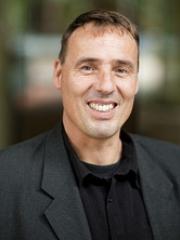Professor Ernst J. Wolvetang

Development of therapeutics for CNS diseases with human personilized stem cell derived organoid models
Professor Ernst Wolvetang obtained his PhD from the University of Amsterdam, continued his post-doctoral training at the Monash Institute for Reproduction and Development, before joining the Australian Stem Cell Centre. In 2008 he was recruited to the AIBN where he heads the Stem Cell Engineering Laboratory and directs the Australian Organoid Facility at UQ as well as the Phenomics Australia NNAT node at UQ. He is a leader in the derivation, genome editing and disease modelling with human induced pluripotent stem cell and organoids derived from these. He was awarded the 2014 LSQ regenerative medicine prize. Professor Wolvetang serves on the editorial board of six stem cell journals; is listed inventor on four patents in stem cell research and serves as a scientific advisor to the Massimo Foundation, BrAshAT and Genetic Cures for Kids. Leveraging robotic automation and in vitro disease models his focus is to exemplify how pre-clinical testing of personalised drug and gene-therapies in human organoid models can accelerate and improve health outcomes for patients rare genetic or common acquired diseases but also for our ageing population.
Industry
Prof Wolvetang leads a number of industry projects with national and international biopharmaceutical companies that leverage the human disease and organoid models and the robotic infrastructure established in the Wolvetang laboratory to conduct pre-clinical screening o their lead compounds.
Collaborations
Professor Wolvetang collaborates with leading clinical researchers of neurological diseases such as A/Prof Lata Vadlamudi, Prof Patrick Kwan, Prof Terence O/Brien and Prof David Coman. He works closely with leading researchers in the Ataxia Telangiectasia field such as Prof Martin Lavin and Prof Yossi Shiloh (Israel), with leaders in the gene therapy for white matter diseases such as Prof Matthias Klugmann, and virology experts such as Prof. Alexander A. Khromykh. Prof Wolvetang further manages a number of collaborations with industry partners that focus on pre-clinical organoid-based drug screening.
Funding
2022-2024 2022 MRFF Stem Cell Therapies Mission. Application ID:2024380. Moon's Mission: creating a replicable therapeutic framework for hereditary spastic paraplegias. Wolvetang, Klugmann, Coman, Leeson, Leventer, Gillam, Ross, Froehlich.
2023-2026 NHMRC Ideas grant. Application ID: 2020434 A human brain organoid model of acute prenatal hypoxia enables biomarker discovery and drug screening for hypoxic-ischemic encephalopathy. CIA Wolvetang, CIB Mar, CIC Pietrogrande, CID Bjorkman.
2022-2023 The Michael J. Fox Foundation for Parkinson's Research: Target Advancement Program - Tool Generation. Characterization of the Kir4.2 channel as a critical new target for Parkinson's disease. CIA Ma, CIB Richardson, CIC Wolvetang, CID Mellick.
2022-2023 ELA foundation ELA 2021-024F2. Deciphering disease heterogeneity: Spatiotemporal analysis of molecular and cellular pathology in HBSL. CIA Wolvetang, CIB Pietrogrande
2021- 2024 NHMRC 2020 Stem Cell Therapies Mission Application ID: 2009101.Identification and assessment of new treatment options for the childhood cancer Neuroblastoma $982,101 Schwarz, Khew-Goodall, Wolvetang, Kavallaris, Fletcher, Goodall, Kirby, Jessop, Thomas, Pillman
2021-2022 Moon Atlas Trust. Hereditary Spastic Paraplegia Research Model
2021-2024 NHMRC 2020 MRFF Childhood Cancer Research Application APP2007404. ABOLISH Neuroblastoma: Defining the Aetiology and underlying BiOLogy of neuroblastoma to Innovate and SHape new options for prevention, diagnosis and treatment, CIA Khew-Goodall CIB Goodall, CIC Kirby, CID Schwarz, CIE Polo, CIF Wolvetang, CIG Pillman, CIH Jessop, CII Thomas.
2021-2024 NHMRC- MRFF-Stem Cell Mission APP 2007653 Personalising Epilepsy Regimes with Stem cells and artificial Intelligence models for Superior Treatment outcomes. (PERSIST). CIA Wolvetang, CIB Kwan, CIC Vadlamudi, CID O'Brien, CIE Ge, CIF Anderson, CIG Shaker, CIH Antonic-Baker, CII Leeson.
2021-2026 NHMRC- MRFF 2020 Genomics Health Futures Mission APP2007498. The Australian Functional Genomics Network. $5 million. CIA Sinclair, Dunwoodie, Bryson-Richardson, Smyth, Mattiske Bennetts, Gecz, Jones, Laing, Palpant, Smith, Stark, Tam, Warr, Baynam, Bowles, Christodoulou, Hardy, Harvey, Heng, Hillard, Hime, Hool, Jamieson, Palmer, Patel, Quinn, Roscioli, Scott, Spurdle, Tan, Thomas, Dudding-Byth, Wallis, Wolvetang, Macarthur.
2020-2023 ARC DP210103401 Safer gene editing tools for Australian livestock and biotech industries. CIA Wolvetang, CIB Perrin
2020-2023 MRFF Clinical Trials - Rare Cancers, Rare Diseases and Unmet Need Grant. Ataxia-telangiectasia: treating mitochondrial dysfunction with a novel form of anaplerosis CIA –Coman CIB –Lavin CIC –Sly CID –Wainwright CIE –Wolvetang CIF - Doctor Sinclair CIG - Dowling
2019-2022 MRFF AR LEUKODYSTROPHIES FLAGSHIP The Massimo Mission. CIA Leventer, CIB Wolvetang, CIC Simons, CID Klugmann
2019-2020 Frontiers MRFF program. Therapeutic Ultrasound for the Treatment of Brain Disorders. Götz , Nisbet, Bodea, de las Heras, Leinenga, Chen, Song, Odabaee, Whittaker, Hine, Wolvetang.
Key Publications
- Atefeh Taherian Fard, Hannah C. Leeson, Julio Aguado, Giovanni Pietrogrande, Dominique Power, Cecilia Gómez‑Inclán, Huiwen Zheng, Christopher B. Nelson, Farhad Soheilmoghaddam, Nick Glass, Malindrie Dharmaratne, Ebony R. Watson, Jennifer Lu, Sally Martin, Hilda A. Pickett, Justin Cooper‑White, Ernst J. Wolvetang*, Jessica C. Mar*. Deconstructing heterogeneity of replicative senescence in human mesenchymal stem cells at single cell resolution. GeroScience (2023) https://doi.org/10.1007/s11357-023-00829-
- Julio Aguado, Harman K. Chaggar, Cecilia Gómez-Inclán, Mohammed R. Shaker, Hannah C. Leeson, Alan Mackay-Sim and Ernst J. Wolvetang. Inhibition of the cGAS-STING pathway ameliorates the premature senescence hallmarks of Ataxia-Telangiectasia brain organoids. Ageing Cell (2021) e13468. https://doi.org/10.1111/acel.13468
- Yin Xiang Setoh*, Alberto A. Amarilla*, Nias Y.G. Peng, Rebecca E. Griffiths, Julio Carrera, Morgan E. Freney, Eri Nakayama, Shinya Ogawa, Daniel Watterson, Naphak Modhiran, Faith Elizabeth Nanyonga, Francisco J. Torres, Andrii Slonchak, Parthiban Periasamy, Natalie A. Prow, Bing Tang, Jessica Harrison, Jody Hobson-Peters, Thom Cuddihy, Justin Cooper-White, Roy A. Hall, Paul R. Young, Jason M Mackenzie, Ernst Wolvetang, Jesse D. Bloom, Andreas Suhrbier, Alexander A. Khromykh Determinants of Zika virus host tropism uncovered by deep mutational scanning. Nature Microbiology (2019) May;4(5):876-87.
- Phipson B, Er PX, Hale L, Yen D, Lawlor K, Takasato M, Sun J, Wolvetang E, Oshlack A, Little M. Evaluation of variability in human kidney organoids. Nature Methods (2019) 16, 79–87.
- Wolvetang E* ,Herszfeld D*, Langton –Bunker E, Chung T, Filipczyk A, Houssami S, Koh K, Laslett AL, Michalska A, Nguyen L, Reubinoff BE, Tellis I, Auerbach JM, Ording CJ, Looijenga LHJ, and Pera MF. CD30 is a survival factor and a biomarker for transformed human pluripotent stem cells. Nature Biotech. (2006) 24(3):351-7.
